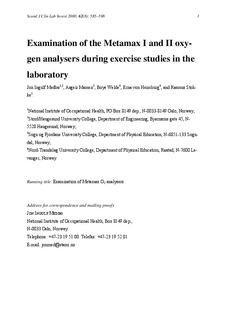| dc.contributor.author | Medbø, Jon Ingulf | |
| dc.contributor.author | Mamen, Asgeir | |
| dc.contributor.author | Welde, Boye | |
| dc.contributor.author | Stokke, Rasmus | |
| dc.contributor.author | Heimburg, Erna Dianne von | |
| dc.date.accessioned | 2009-02-26T13:35:54Z | |
| dc.date.issued | 2002 | |
| dc.identifier.citation | Medbo, J., Mamen, A., Welde, B., Von Heimburg, E., & Stokke, R. (2002, December 15). Examination of the Metamax I and II oxygen analysers during exercise studies in the laboratory. Scandinavian Journal of Clinical & Laboratory Investigation, 62(8), 585-598 | en |
| dc.identifier.issn | 0036-5513 | |
| dc.identifier.uri | http://hdl.handle.net/11250/149301 | |
| dc.description | Dette er en post-print forfatterversjon. For forlagsversjon, se Scandinavian Journal of Clinical and Laboratory Investigation, tilgjengelig online at http://www.informaworld.com/smpp/title~content=t713625785~db=jour. | en |
| dc.description.abstract | The performance of the Metamax I and the Metamax II portable analysers for measuring the O2 uptake has been examined during exercise. Healthy subjects ran on the treadmill or bicycled on ergometers while the O2 uptake was measured by the Metamaxes and in addition by the Douglas bag technique or the Vmax 29. In the first series of experiments the O2 uptake was first measured by one instrument and thereafter by a second. In later experiments two or more breathing valves were connected in series, thus enabling us to measure the O2 uptake simultaneously by more than one instrument. The O2 uptake measured by the Metamaxes rose linearly by the value given by the control methods. However, there were variations of »5% because the relationships differed between the subjects. When the data from each subject were examined separately, the error of regression was 0.5–1 μmol s–1 kg–1 (2–3%), and the error of regression when relating the O2 uptake to the exercise intensity was similar to that found when using the Douglas bag technique alone. In most cases the lung ventilation reported by the Metamaxes was a few percent less than that given by the control methods while the fractional extraction of O2 was higher for the Metamaxes. The respiratory exchange ratio (Rvalue) reported by the Metamaxes agreed well with those of the control methods only in the range 0.9–1.0; for this parameter the Metamaxes do not seem to be reliable for exercise testing.
The O2 uptake and the R-value were also calculated from the raw data reported by the Metamaxes. The calculated values differed somewhat from those given by the instruments, and the calculated values agreed better with those obtained by the Douglas bag technique than those reported by the instrument did. This study suggests that the O2 uptake reported by the Metamaxes is precisely measured within subjects but that there are some systematic errors and in addition variations between subjects. | en |
| dc.format.extent | 149635 bytes | |
| dc.format.mimetype | application/pdf | |
| dc.language.iso | eng | en |
| dc.publisher | Taylor & Francis | en |
| dc.subject | Avdeling for lærarutdanning og idrett | en |
| dc.subject | oxygen consumption | en |
| dc.subject | automatic O2 analyser | en |
| dc.subject | respiratory exchange ratio | en |
| dc.subject | ventilation | en |
| dc.subject | exercise | en |
| dc.title | Examination of the Metamax I and II oxygen analysers during exercise studies in the laboratory | en |
| dc.type | Peer reviewed | en |
| dc.type | Journal article | en |
| dc.subject.nsi | VDP::Medical disciplines: 700::Sports medicine: 850 | en |
| dc.source.pagenumber | 585-598 | en |
| dc.source.volume | 62 | en |
| dc.source.journal | Scandinavian Journal of CLinical and Laboratory Investigation | en |
| dc.source.issue | 8 | en |
